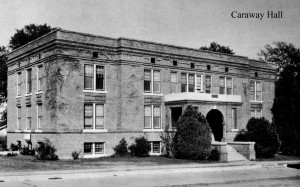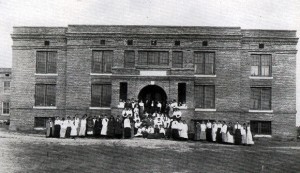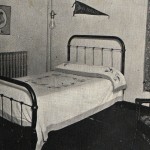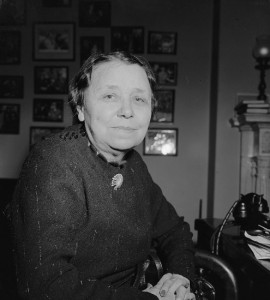
Caraway Hall. Courtesy of Southern Arkansas University Archives, Magnolia, Arkansas. To view larger sizes, click the photos.
Listen here to an audio introduction to the historic Caraway Hall. Narrated by Professor Mark Trout.
Caraway Hall was one of two dormitories built in 1913-1914 on the slight rise, which students called “Aggie Hill,” at the Third District Agricultural School. Caraway Hall sat next to Jackson Hall, at the east end of the row of the school’s original buildings. Students soon nicknamed their school TDAS.
Originally known as the New Women’s Dorm, the building was named in 1935 for Senator Hattie W. Caraway of Arkansas, the first woman elected to the United States Senate. Caraway’s election was secured when the controversial but popular senator from Louisiana, Huey P. “the Kingfish” Long, conducted a whirlwind campaign to support her. Long and Caraway held a rally at the Magnolia courthouse square in August 1932.
When Caraway Hall was completed in 1914, it was decided that it would serve as a women’s dormitory and that Jackson Hall would also house women rather than the men originally living there. Men were moved to Holt Hall. Caraway’s larger twin, McCrary Hall, for men was also built in 1913-1914 on the west side of campus.
The arrangement was part of a general policy to segregate the sexes. Since male students worked in farm barns on the campus’s west side, housing women in Jackson Hall and Caraway Hall kept men from walking near coeds on the way to work.

Students at Caraway Hall in 1916. Courtesy of Southern Arkansas University Archives, Magnolia, Arkansas.
The only time young men were permitted on the east side of campus was on Sunday. On that day of rest, young men could call at Caraway Hall and Jackson Hall and invite a date to walk about campus, but only adult observation.
Caraway Hall was a three-story brick building with a flat roof, large windows, and a wooden interior whose first floor was partially underground. The large windows were necessary for ventilation in an era without air conditioning. The Texarkana architectural firm of Witt-Seibert & Company designed the building, and the general contractor was C. A. Powell Construction Company of Magnolia. Construction cost totaled $14,106.
The building’s area of 10,800 square feet was intended for seventy-five residents, two per room. Over the years, however, large enrollments occasionally necessitated using bunk beds to place three or four students in each room.

A room in Caraway Hall in 1923. Courtesy of Southern Arkansas University Archives, Magnolia, Arkansas.
Unlike those in Jackson and Holt Hall, rooms in Caraway Hall were kept warm in winter from the beginning with steam heat. A steam boiler plant with pipes connected to all buildings was also built in 1913-1914.
Caraway Hall served as a women’s dormitory until 1951. At that time, all women on campus were transferred to the newly built Bussey Hall. From 1951 to 1955, Caraway was a men’s dormitory. In 1955, Caraway was converted to a classroom and faculty office building. It was used by the Social Science Division until 1970, the Education Division until 1976, and the Art Department until 1991.
Efforts during the 1980s and early 1990s to raise funds to preserve Caraway Hall as an historic structure of the original campus proved unsuccessful. The building was torn down in 1994.

